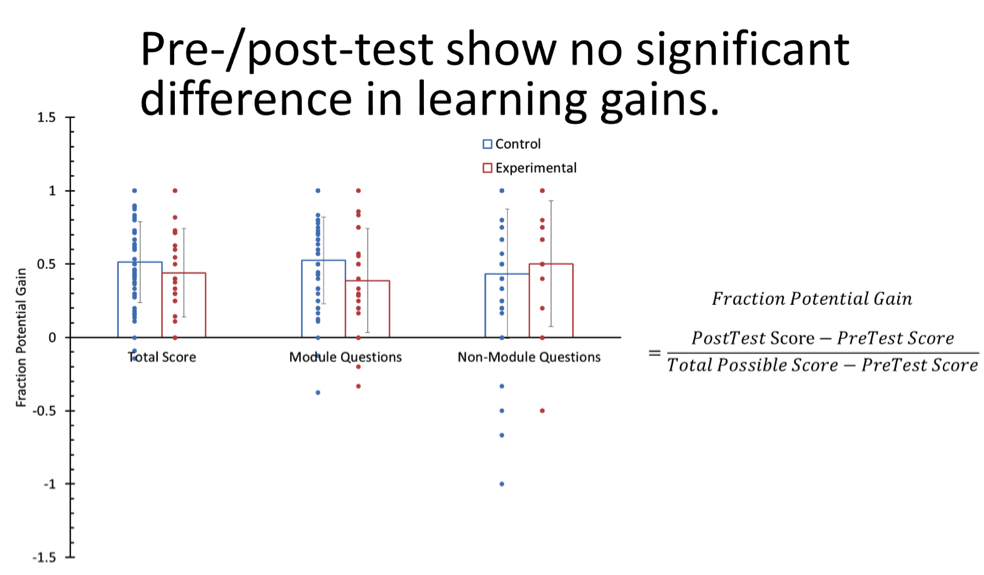Table Of Content

You likely would not give them the exact same tests because there's a practice effect, defined as an influence on performance from previous experience. So if you have them do the exact same car driving sequence, they may have learned a pattern or become familiar with the machine. If you give them the exact same general knowledge test, then they may have looked up some of the answers or had a chance to remember more.
Academy of Art University

A Best Colleges rank of #191 out of 2,217 schools nationwide means Chapman is a great university overall. Sickle cell disease (SCD) is a common inherited blood condition caused by a mutation in the synthesis of hemoglobin (Hb) resulting in either a homozygous or heterozygous state with another abnormal hemoglobin [1]. The most common and most severe form of SCD is the homozygous state known as Sickle Cell Anemia (SCA) due to inheritance of hemoglobin S (HbS) from each parent [1]. The inheritance of HbS in heterozygous state with a normal Hb is known as sickle cell trait which is not part of SCD [1]. GN, UF, EF, DKT conceptualized the project, designed the research methodology, substantively revised the manuscript and ultimately approved the submitted version. We present a decision ‘map’ approach based on a Figure 5 to assist in considering decisions in selecting among QEDs and for which features you can pay particular attention to in the design [Figure 5 here].
Advantages of the separate-sample pretest-posttest design:
External validity can be improved when the intervention is applied to entire communities, as with some of the community-randomized studies described in Table 2 (12, 21). In these cases, the results are closer to the conditions that would apply if the interventions were conducted ‘at scale’, with a large proportion of a population receiving the intervention. The study by Grant et al et al uses a variant of the SWD for which individuals within a setting are enumerated and then randomized to get the intervention. Individuals contributed follow-up time to the “pre-clinic” phase from the baseline date established for the cohort until the actual date of their first clinic visit, and also to the “post- clinic” phase thereafter. In our analyses we used the standard deviation of the pre-post differences (σdif) as the standardizer of our single-group ABC statistic, but other standardizers are also available.
Is a before-and-after study observational?
With low antenatal care attendance by pregnant women in health facilities in Nigeria, community-based programs could enable increased reach for health education about sickle cell disease (SCD) and newborn screening (NBS) among pregnant women. This pilot study aimed to assess the effect of education on the knowledge about SCD and NBS among pregnant women using the Healthy Beginning Initiative, a community-based framework. An example of a pretest-posttest design could have participants in a healthy diet habits development program take a pretest regarding their eating and exercise habits. These behaviors may include how many calories they consume daily, or how many minutes of physical activity they perform daily.
The study assessed participants’ clinical reasoning before and after their engagement in an intervention involving VP cases as a CPD learning approach. Utilizing VP cases appears to significantly enhance the continuous professional development of nurses, fostering a deliberate learning process that enables them to reflect on how they manage cases and, in turn, refine their clinical reasoning skills. This study strongly recommends incorporating VP cases in the continuous professional development of nurses at the primary health level (health centers).
Confidence Interval for a Standard Deviation
The study used pre-test and post-test paper cases to assess the clinical reasoning skills change before and after the intervention. At the study’s outset, 76 participants consented to participate, yet only 56 completed the study intervention, enabling their participation in the post-test assessment. While there is a possibility of attrition bias, as we lack information about whether the scores of those who dropped out of the study differed systematically from those who completed, we do not suspect that attrition was based on any systematic characteristic. This attrition issue may have been influenced by work responsibilities and other daily commitments, potentially hindering some nurses from completing the study. Following this summary, we discuss opportunities to strengthen their internal validity, illustrated with examples from the literature.
Specifically, we focus on situations in which the same variable is measured at two time points in all the individuals in the sample (i.e., Pre-post research designs). I am glad to inform you that there is a methodology very similar to this, most of the time occurring without the stick. A pretest-posttest design is usually a quasi-experiment where participants are studied before and after the experimental manipulation.

Front-loading of anatomy content has no effect on long-term anatomy knowledge retention among physical therapy ... - BMC Medical Education
Front-loading of anatomy content has no effect on long-term anatomy knowledge retention among physical therapy ....
Posted: Tue, 14 Sep 2021 07:00:00 GMT [source]
The interventions can be quite varied; examples include administration of a drug or vaccine or dietary supplement, performance of a diagnostic or therapeutic procedure, and introduction of an educational tool. Lynch and Johnson used a separate-sample pretest-posttest design to evaluate the effect of an educational seminar on 24 medical residents regarding practice-management issues. Finally, adding a control group to the separate-sample pretest-posttest design is highly recommended when possible, as it controls for History, Maturation, Mortality, and Instrumentation at the same time. This design is good at measuring opinions or behaviors not present at the beginning.
Study design
One strategy involves creating a cohort, and then using targeted sampling to inform matching of individuals within the cohort. Matching can be based on demographic and other important factors (e.g. measures of health care access or time-period). Lastly, you will compare the participants' pre- and posttests to see if being dirty affected their judgment or general knowledge. The purpose of this experiment was to demonstrate if there was a change in the participants brought on by your experimental manipulation. If the posttest is significantly different from your pretest, then your manipulation caused some kind of change. Remember, this is a quasi-experimental study since all of the participants went 36 hours without cleaning.
The authors thank the pregnant women who participated in the baby showers, the church health teams, and the member of the Clergy. We acknowledge the HBI Program Team (Dr. Ifeyinwa Nnakenyi; Dr. Adanma Ekenna; Dr. Onyinye Enebe; Dr. Chinazo Ekwueme; Dr. Johnbosco Chukwuorji; Chioma Onu; and Stephen Orafa). We also acknowledge Dr Alisa Lincoln for reviewing the manuscript and providing material support.
Web-based VP systems for learning may have different structures according to the learning goals in focus. Before starting this study, the researchers adopted an existing web-based VP system developed at Stockholm University, called Virtual Case System (VCS), into the local context of health centers in Rwanda on how they collect patient information and make decisions. In addition, researchers chose the NCDs of hypertension, depression, prostate cancer, and gastric cancer to be included in this study as VP cases.
However, such studies need a somewhat larger sample size than individual-randomized studies and the use of special statistical tools for data analysis. Sometimes, an intervention cannot be easily administered to individuals but can be applied to groups. In such cases, a trial can be done by assigning “clusters” – some logical groups of participants – to receive or not receive the intervention.


No comments:
Post a Comment